Authentic Antique Japanese Koshida Hand Painted Satsuma Vase From Meiji Period
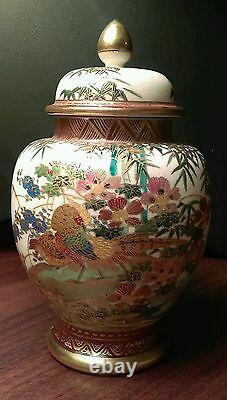

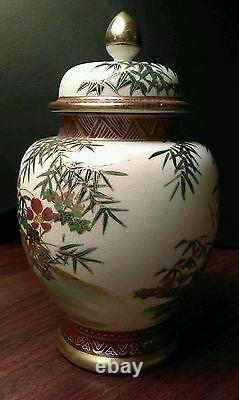
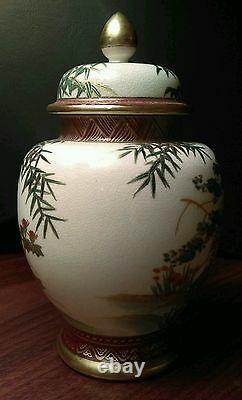
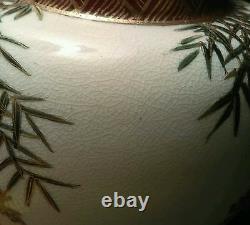

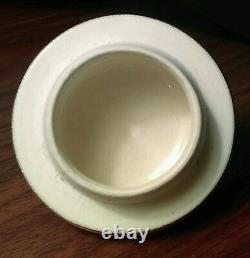
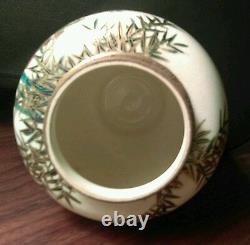


I have for sale an authentic, antique, handmade, hand-painted Koshida Satsuma covered vase. The vase dates back to the Meiji period and was made between 1880 and 1912. It has been dated by examining the maker's mark and the chosen painted design. Both are known attributes conducive to the time period. The bottom is clearly marked by hand with the Shimazu Clan family crest, which is a circle with a cross in it and the Koshida kanji characters.
Koshida produced Satsuma pieces from 1880 until approximately 1927. During the time period Koshida was known for making high quality pieces painted by some of the finest artists in Japan. Needless to say, their pieces today are sought after by collectors. It is in mint condition with no damage of any kind. Vase measures: Height: 7" with lid Circumference: 13" The vase has all the telltale signs of being authentic. If you are truly interested in owning an authentic Satsuma piece then I strongly suggest you read all of the following.Also please take the time to visit a few of the many informative online Satsuma websites. The more you know the better your chances are of purchasing an authentic original for the right price. First of all, look to see if there is any English words on the marking, such as "Made In Japan" or "Hand Painted".
If there are, then the piece is most certainly NOT an antique. Once the Satsuma style was seen by the general public and became a popular look, the style was mass produced across the world (usually in China) and stamped with these sorts of markings. If your piece has this on, it is probably made in the later half of the 20th century. CHECK FOR THE SHIMAZU FAMILY CREST.
Another good sign of an authentic antique mark is the presence of the Shimazu family crest. A simple circle with a cross through it is the sign of the clan that ruled the Satsuma province in Japan around the time that most of the original items were made.
If this crest is on the pottery item, then you most likely have an original piece. The crest should also be accompanied by a signature or mark of the maker and is often painted in gold strokes.
The Kanji (Japanese symbols) will often be the name of the maker or sometimes a number, placing the piece as one of a series of potteries, designed to be displayed in a certain order. IS THE MAKERS MARKING HANDPAINTED OR STAMPED? All of the original Satsuma pottery pieces were made, glazed and painted by hand. Therefore, you should be able to see if the marking has been painted by hand or stamped on. If a stamp or print has been used to mark the piece, you may have a more modern item - most likely mid to late 20th century and worth less value. Obviously, a stamped mark will look more perfect than a hand painted one, so it should stick out like a sore thumb. One of the obvious differences between porcelain and earthenware pottery is that the former is very thin, which allows you to hold the item and tap it, producing a "ring" sound. You can probably test this on some more modern items you have at home. The fact that Satsumaware is made from clay and earth means that they have generally thicker "walls" and the material will not allow a "ring" when tapped. You can test your Satsuma piece yourself to see if it will produce a high pitched ring when tapped. If you get a dull sound, then you are more likely to have a genuine piece. There are multiple websites with extensive information on maker marks and which artist or factory they belong to. Quality Satsuma pieces were only made in Japan and all the maker's marks have been identified and catalogued. They are simply hoping to make a sale in an unscrupulous manner. If you have any questions please feel free to contact me. The item "Authentic Antique Japanese Koshida Hand Painted Satsuma Vase From Meiji Period" is in sale since Tuesday, October 18, 2016. This item is in the category "Antiques\Asian Antiques\Japan\Vases".The seller is "via_veritas" and is located in Montrose, California. This item can be shipped to United States, United Kingdom, Denmark, Romania, Slovakia, Bulgaria, Czech republic, Finland, Hungary, Latvia, Lithuania, Malta, Estonia, Australia, Greece, Portugal, Cyprus, Slovenia, Japan, Sweden, South Korea, Indonesia, Taiwan, Belgium, France, Hong Kong, Ireland, Netherlands, Poland, Spain, Italy, Germany, Austria, Israel, Mexico, New Zealand, Singapore, Norway, Saudi arabia, United arab emirates, Qatar, Kuwait, Bahrain, Croatia, Malaysia, Panama, Jamaica, Chile, Costa rica, Trinidad and tobago, Guatemala, Honduras, Bahamas, Viet nam, Uruguay, Egypt, Peru, China, Thailand, Switzerland, Brazil, Bangladesh, Brunei darussalam, Bolivia, Ecuador, French guiana, Guernsey, Gibraltar, Guadeloupe, Iceland, Jersey, Jordan, Cambodia, Liechtenstein, Luxembourg, Monaco, Macao, Martinique, Nicaragua, Pakistan, Paraguay, Canada, South africa, Colombia, Barbados, Bermuda, Cayman islands, Sri lanka, Maldives, Oman, Reunion, Philippines, Ukraine.
- Primary Material: Earthenware
- Age: 1880-1912 Meiji Period
- Type: Vases
- Region of Origin: Satsuma, Kyushu Island, Japan
- Color: Multi-Color
- Maker: Koshida

